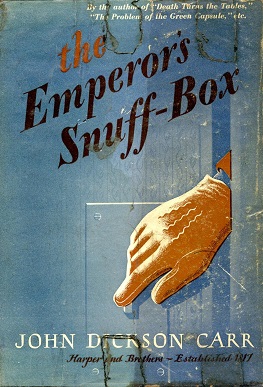This is an old revision of this page, as edited by Accounting4Taste (talk | contribs) at 18:18, 11 August 2010 (removing uncited opinion). The present address (URL) is a permanent link to this revision, which may differ significantly from the current revision.
Revision as of 18:18, 11 August 2010 by Accounting4Taste (talk | contribs) (removing uncited opinion)(diff) ← Previous revision | Latest revision (diff) | Newer revision → (diff)| This article does not cite any sources. Please help improve this article by adding citations to reliable sources. Unsourced material may be challenged and removed. Find sources: "The Emperor's Snuff-Box" – news · newspapers · books · scholar · JSTOR (September 2008) (Learn how and when to remove this message) |
 1st US edition 1st US edition | |
| Author | John Dickson Carr |
|---|---|
| Language | English |
| Genre | Mystery, Detective novel |
| Publisher | Hamish Hamilton (UK) & Harper (USA) |
| Publication date | 1942 (US), 1943 (UK) |
| Publication place | United Kingdom |
| Media type | Print (Hardback & Paperback) |
| ISBN | NA Parameter error in {{ISBNT}}: invalid character |
The Emperor's Snuff-Box is a non-series mystery novel (1942) by mystery novelist John Dickson Carr. The detective is psychologist Dr. Dermot Kinross.
The novel takes place in France and concerns a jeweled snuff-box in the shape of a pocket watch said to have belonged to Napoleon. A pretty young Englishwoman living in France forms a romantic attachment and becomes a suspect in the murder of her fiance's father; the theft of a valuable necklace and the smashing of the snuff-box are also mysteries to be solved.
The novel served as the basis for the 1957 film That Woman Opposite, for which the screenplay was written by Compton Bennett.
This article about a mystery novel is a stub. You can help Misplaced Pages by expanding it. See guidelines for writing about novels. Further suggestions might be found on the article's talk page. |